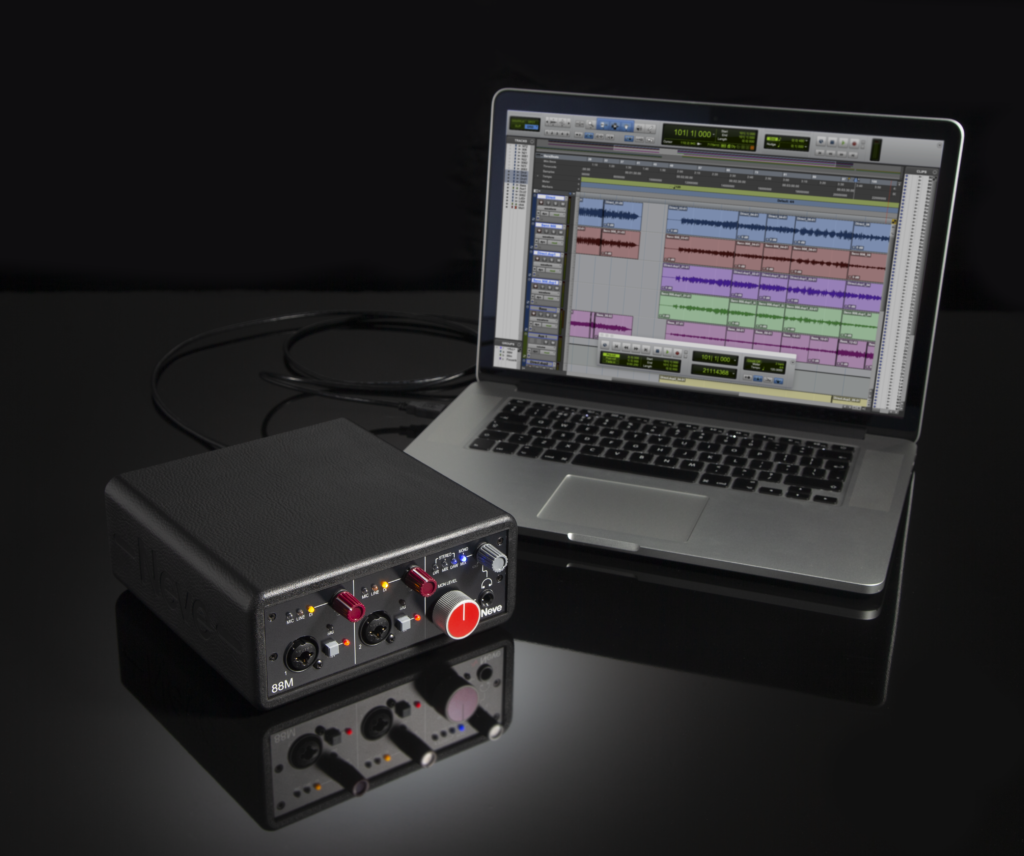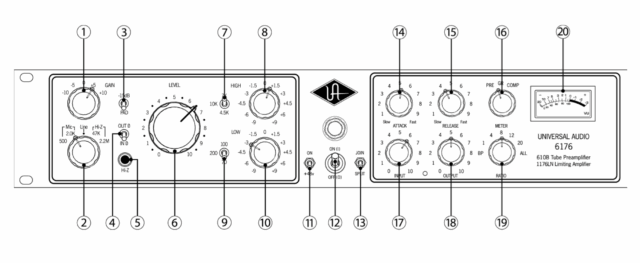Tagged: @JBear, 1073, 1081, 1176, 31102, 6176, 88m, Apollo, channel strip, compression, compressor, limiter, limiting, mic pre, neve, preamp, UA Solo, UAD
-
Thoughts on 88M?
Posted by Bar Rose on August 29, 2025 at 5:44 amHey MP 🙂
I’m eyeing the Neve 88M console preamp for my home studio. Anyone here used it – or prefer a different two-channel option?
Context: my current chain is a loaner UAD 6176 → Apollo Solo.
I have to return the 6176, so I thought I’d replace my current chain (including the Apollo Solo) with the 88M – But I want to be sure the 88M wouldn’t be a downgrade.
I rarely use the 6176’s limiter and mostly treat it as a preamp, so I’m mainly comparing preamp quality and conversion.
Recording mainly vocals + acoustic and electric guitars + bass.
What would you pick?
Link to the 88M console preamp: https://www.ams-neve.com/88m/
Thanks!
ams-neve.com
The 88M uses the same transformer-balanced technology as Neve's flagship large-format 88RS, the 88M brings the legendary sound of AIR, Abbey Road and Capitol Studios into your home and portable studio setup.
Dana Nielsen replied 3 weeks ago 5 Members · 15 Replies -
15 Replies
-
Hey @barrose! Love this question, and thanks for the thoughtful context!
You’re comparing a few solid options: your current UAD 6176 (which I also own and recommend often), your Apollo Solo, and the Neve 88M you’re considering. I know the 6176 is on loan or going away, so the core of your question is: Is the 88M a step forward or a step back?
Here’s my honest take…
TL;DR: Preamp ≠ Magic … EQ + Output Control = Magic
The Neve 88M is no doubt a high-quality piece of gear. But so is your Apollo Solo, and honestly, when it comes to just mic preamps, the differences between most units – even boutique ones – are often overstated, especially in a clean, low-gain scenario like vocals or acoustic guitar. Both the Solo and 88M offer clean, low-noise gain with solid conversion.
But what I personally really care about in a preamp isn’t the name on the front, it’s:
-
A bit of EQ (even just a top-end shelf or low cut)
-
An output fader (so I can push the input gain and back off the output for harmonic saturation)
That’s why I love the 6176. With input and output controls, you can drive the tube preamp for tone and still maintain proper recording levels … something neither the 88M nor Apollo Solo really let you do.
If your 6176 is going away and you want to replace both your interface and preamp in one move, then sure, the 88M can work, but it’s not likely to sound radically better than your Apollo Solo. Without EQ or output trim, it’s just… gain.
And when you’re not pushing gain into breakup or leaning into transformer coloration, most preamps (yes, even Neve) are going to sound more alike than different.
My Real-World Suggestion:
If it were me, I’d either:
-
Keep using your Apollo Solo and take full advantage of the UAD Console to add EQ/compression on the way in (just like you’d print with a 6176), OR
-
Invest in a more full-featured channel strip, something with EQ and output control that lets you shape your sound before hitting the DAW
$1,200 is a lot to spend on another “clean” preamp when you already have one in the Apollo. That money might go further toward a versatile mic, plugin suite, or even a 6176 of your own!
🎛️🎚️
Ultimately, the Neve 88M is well-built, but I wouldn’t expect it to be some massive sonic upgrade over what you already have unless you’re specifically craving that Neve badge or want to simplify your rig with an all-in-one interface.
Hope that helps! And would love to hear what others think, especially if anyone’s using the 88M and has A/B’d it with UA gear!
⚡️ Dana
-
- Great video! And, as always, you’re totally right.
Now, what shall we do with those $1,200… mmm…
-
Haha – thanks, Sharon! (and sorry for the delayed response!)
- Great video! And, as always, you’re totally right.
-
-
Hi Dana,
Thank you for the detailed and super-helpful insight – I’ll stick with the Apollo for now.
Following your advice, I’m looking to add a hardware channel strip next and I’m leaning toward getting my own UA 6176.
For a vocals-and-guitars–focused setup, would you consider it essential, or are there other strips you’d recommend instead?
On another note, your “drive the pre, ride the output” note was a gem! I’d overlooked how much the 1176 side can do as a post-drive trim, and honestly have been avoiding using it. It’s a bit of a mystery to me, and I’m not sure how to use the 1176 on vocal & guitar recordings.
Love to hear your thoughts / tips about this piece of machinery and unravel its mystery 🙂
From what I could peice together, I’m thinking of two gain-staging approaches (with and without compression) for vocals and guitars in mind:
A) Keep the 1176 at 1:1 and use its Output to set level while pushing the 610 for color.
B) Apply light compression: set 4:1, aim for ~1-3 dB of GR, then trim with the compressor’s Output.
What do you think?
Thanks so much!
-
Yay! Glad u got some good tips from it, @barrose!
A) You can actually drive the preamp input (1) and turn down the output (6) of the preamp independent of the compressor. You can, for example, bypass the compressor and use the Preamp Out (XLR on back of the unit) straight to the line input of your Apollo.
B) yep!- you can also link the Preamp Out to the Compressor In using the front-panel Join switch (13). 1-3db of reduction at 4:1 would be a safe conservative setting for natural sound. But don’t miss the more exciting/hype-y sounds you can get with that 1176-style compressor! The setting I use for almost everything on any 1176 is Slowest Attack, Fastest Release, 4:1. Push the compressor input until it sounds too compressed, then dial back the input to taste, always adjusting the compressor output as needed to avoid digital overs in your DAW.
Oh, and here’s a link to the manual – Page 3 has a great description and overview!
-
Hey Dana,
As I was recording this instrumental, the meter was living in the red while Sharon was on electric – felt like a bit of an outlaw 🙂
I also used the UAD compressor to tame the bass peaks – what a ball that was, I love how it helps control the track dynamically.
By the way, I’ve been using a few tricks from your thread with Paul about ducking in Pro-Q4 and got tempted to apply it almost everywhere – ducking the reverb, the bass under the kick, you name it. Am I getting too trigger-happy with it? Any downsides or alternative approaches you’d suggest?
Side note – this instrumental is my first time using the Behringer LM Drum, which was surprisingly fun. I’m actually considering picking up either their take on the 6176 or their Neve-style dual preamp console – looks like I have to return my 6176 loaner.
I’d love to hear your general thoughts on these kinds of lower-cost recreations of high-end gear – what do you think of that approach in general?
There’s no ending to this instrumental yet since I still have to write the next part!
-
Bar,
This is moody and pretty already. I was hoping @JBear would suddenly appear vocally and take it further.
-
Thank you, Paul!
I have to admit I was tempted to lay down vocals — looks like I’ll be uploading a version of this no-longer-instrumental instrumental to Mix Protégé soon. 😄
-
-
Hey Bar! (and @sexton)! Wow, I love this – such beautiful playing and recording! And to @-PT‘s point, I agree — @JLew will totally dig this awesome instrumental 😊.
“Outlaw” lolol – perfect word for that wonderful feeling of “breaking the rules” with your equipment. Haha, love it! Whatever you’re doing to “abuse” that 6176 sounds GREAT – keep it up!
I’m not familiar with those other specific pieces of gear you mentioned but in general, heck yeah, these days it’s easier and easier to get expensive-sounding results using budget-friendly gear. You could probably even return/exchange for something different if you’re not satisfied with your first choice (assuming you’re buying something new from Guitar Center, Sweetwater, Amazon, etc.).
No matter the brand/model you settle on, per the video above in this thread, I would just try to find a piece (or pieces) of gear that ‘check the same boxes’ as that 6176 if you can:
- Input gain AND output fader/knob (to control digital peaks when you’re in “Outlaw Mode” 🤠)
- EQ for tone shaping on the way into your DAW
- Compressor/limiter option for shaping dynamics on the way in, and controlling peaks/overs in your DAW
Let us know what you decide on, Bar!
I’m gonna listen to that instrumental again now, cause it’s so nice! 🙌
-
Hey Dana glad you liked it!
The owner of the 6176 has surprisingly not followed up on his request to get it back, so in the meantime I’ll be enjoying this beautiful piece of gear
This thread really helped me understand how to color and compress my recordings. It got me thinking about how saturation affects different instruments — some might actually sound nicer without that extra color, keeping them more neutral. With acoustic guitars I find myself not wanting to oversaturate them.
I’m curious to hear what other Protégé folks prefer when it comes to instruments and saturation. Maybe I’m overgeneralizing, and it’s just the particular type of color that the 6176 gives that doesn’t fit every instrument — but it definitely got me thinking that some things just want to be recorded neutrally or maybe naturally.
-
That’s great news, Bar! I’m glad you’re able to hang onto that 6176 a bit longer and get some more use outta it!
Great question re saturation and when to use it.
For me, it’s really song/production-dependent. Acoustic guitar is a good example. If I’m recording a delicate singer-songwriter style track I’m usually looking for a full-range, high-fidelity acoustic guitar sound with no need for saturation. I may still compress it on the way into pro tools to get a good level without digital overs, but I prob wouldn’t drive the mic pre toward saturation in that instance.
However, I LOVE adding mic pre input gain saturation to acoustic guitars in a rock production! Like, if the strummy rhythm acoustics enter in the chorus… I need them to be loud and proud so they cut through the mix and fit nicely against hard-hitting drums and electric guitars. Even if it’s a folk-rock americana style, I might push the preamp input a bit hotter – not looking to “hear distortion” in the signal, but more to control peaks a bit and give the sound a subtle edge. In this case the amplifier component (the 610 input tube amp on your 6176) will kinda shave off the loudest peaks. This can work to your advantage, kinda like a compressor before your compressor – and it sounds cool in the right context!
Very cheap or poorly made preamps and other analog components sound terrible when overloaded like this on input. In my opinion, this is a huge part of what makes Neves, APIs, your UA 6176, and other great equipment so sought after — how they handle the extremes (intended AND unintended extremes, haha)! Great gear sounds AWESOME when pushed to the extreme, opening up new creative options. Not-great gear sounds harsh, unforgiving, and unusable.
-
Very cool and clearly put.. I’ll definitely keep these guidelines in mind when working in my studio
Thank you Dana!
-
-
Hey Bar!
Love this dreamy track! I’m sitting in a lodge in the Rocky mnts after a very long day of travel and just playing it on repeat. It’s soothing my soul.
May I ask what was the bass sound you were using? Love that sound!
Best,
JBear
-
Hey Jesse!
Thanks a lot, sounds like a great place to be listening from.
I wish I’d written the settings down before I messed with them again (trying to get better at that now), but the chain was my Gibson SG bass going into the 6176 with a bit of saturation — nothing too heavy, just enough grit to give it some warmth. Following Dana’s advice, I was already compressing the signal with the 6176 by a few dB before it went into the DAW.
glad you liked it!
-
-
-
-
Log in to reply.



